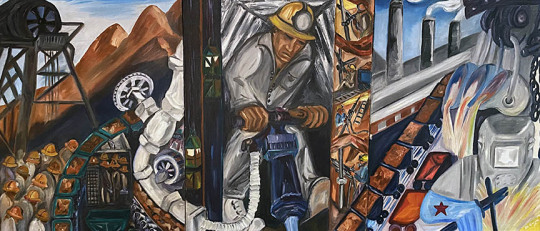#ThrowbackThursday
Photo

While living in Bisbee, Arizona in the 1930’s DeGrazia started creating art as a social statement about class struggle. “Mining” is a triptych depicting mining companies and the indispensable role of the workers who operate the machinery. Happy Throwback Thursday!
“Mining”, oil on canvas, from 1936 will be on display in our new exhibit “DeGrazia Underground: Miners and Prospectors of the Old West”. Please join us tomorrow evening, from 5-7pm, for our opening reception. The event is free and open to the public.
#TedDeGrazia #DeGrazia#Ettore#Ted#Artist#NationalHistoricDistrict #GalleryInTheSunMuseum#Museum#Gallery#Nonprofit #Foundation#Adobe#Architecture#Tucson#Arizona#AZ#SantaCatalinas#Desert#ThrowbackThursday#TBT#BisbeeMiners#Mining#OilTripych#Miners
32 notes
·
View notes
Photo

While DeGrazia was sitting at Rosita's Mexican Restaurant (located next to his first studio) a man walked in and shouted to him from across the room. He said," Hey! You DeGrazia?!" DeGrazia did not reply, and kept talking with his friend. The man, who obviously did not like the artist, strode over to his table and interrupted him. He said to DeGrazia, "You're that guy who thinks you can paint on whatever you want, right? No rules, you just do whatever you want!" DeGrazia still did not say anything. There was a basket of tortillas on the table, so Ted took one out and began to paint it. When he finished, he took his brush and he autographed the angry man's clean, white shirt. Before the man stormed out, cursing at the artist, the only thing DeGrazia said to him was, "Now I have painted on everything." The man did not bother to take his original tortilla painting with him, so DeGrazia kept it and it’s on display at the gallery. Happy Throwback Thursday!
#TedDeGrazia #DeGrazia#Ettore#Ted#Artist#NationalHistoricDistrict #GalleryInTheSunMuseum#Museum#Gallery#Nonprofit #Foundation#Adobe#Architecture#Tucson#Arizona#AZ#SantaCatalinas#Desert#TortillaPainting#ThrowbackThursday#TBT
6 notes
·
View notes
Photo

In 1936 Alexandra Diamos met DeGrazia at the UA when the young student was planting olive trees on campus by day and leading the DeGrazia band at night. As she recalled, “The band leader put down his baton and began playing a trumpet that was sweet as honey with long sweeps of pain and longing…and when the soloist finished there was a thunder of applause.” Her father, Fox Theater owner Nicholas Diamos, consented to the marriage with the promise that DeGrazia finish his BA degree. The couple had three children but divorced in 1946. Happy Throwback Thursday!
#TedDeGrazia #DeGrazia#Ettore#Ted#Artist#NationalHistoricDistrict #GalleryInTheSunMuseum#Museum#Gallery#Nonprofit #Foundation#Adobe#Architecture#Tucson#Arizona#AZ#SantaCatalinas#Desert#ThrowbackThursday#TBT
4 notes
·
View notes
Photo

In 1942, DeGrazia traveled to Mexico City where he met Diego Rivera, Mexico's master muralist. Rivera was taken with DeGrazia's artistic talent and agreed to take him on as an apprentice. DeGrazia assisted Rivera with murals at the Palacio Nacional and the Hospital de Jesus. DeGrazia also worked with José Clemente Orozco during this apprenticeship. The two Mexican masters sponsored an exhibition of DeGrazia's paintings at the Palacio de Bellas Artes in Mexico City during 1942. Happy Throwback Thursday!
#TedDeGrazia #DeGrazia#Ettore#Ted#Artists#NationalHistoricDistrict #GalleryInTheSunMuseum#Museum#Gallery#Nonprofit #Foundation#MexicoCity#DiegoRivera#JoséClementeOrozco#Muralists#PalacioDeBellasArtes#ThrowbackThursday#TBT
3 notes
·
View notes
Photo

Part of DeGrazia's Master's Thesis titled: "Art and Its Relation to Music In Music Education" included a 'Color Machine' which he built to measure the different levels of tone and pitch when music was being played. DeGrazia assigned specific emotions, shapes, and colors to his 'Color Music Pattern Test'. He gave the test to over 350 students at the University of Arizona and made each student listen to classical music, including Stravinsky's Nightingale, and Beethoven's Symphony #8. He would stop the music in certain intervals and ask each student what colors and shapes they saw. They would then draw what shapes they had seen. Happy Throwback Thursday!
#TedDeGrazia #DeGrazia#Ettore#Ted#Artist#NationalHistoricDistrict #GalleryInTheSunMuseum#Museum#Gallery#Nonprofit #Foundation #Adobe#Architecture#Tucson#Arizona#AZ#SantaCatalinas#Desert#ThrowbackThursday#TBT#ColorMachine#MastersThesis#UofA
6 notes
·
View notes
Photo

DeGrazia said, “When I say I am intimately acquainted with every adobe in my studio, I mean it. I put them up. And as I felt the need for more room, I added another studio––one for display, one for painting, one for ceramics, one for living quarters.” Happy Throwback Thursday!
#TedDeGrazia #DeGrazia#Ettore#Ted#Artist#NationalHistoricDistrict #GalleryInTheSunMuseum#Museum#Gallery#Nonprofit #Foundation#Adobe#Architecture#Tucson#Arizona #AZ#SantaCatalinas #Desert#ThrowbackThursday#TBT
3 notes
·
View notes
Photo


Although best known for its color photography, Arizona Highways Magazine also featured regional artists. After seeing Ted DeGrazia’s exhibit “Dust of Mexico!” at the Arizona Inn in Tucson, Raymond Carlson the editor of the magazine became a lifelong fan, friend, collector, and promoter of the artist. He introduced DeGrazia to the readers of Arizona Highways in the February 1941 issue and many more issues after that. Raymond Carlson and Arizona Highways paved the road to success for Ted DeGrazia, as the national and international reach of the magazine exposed the regional artist’s work to a far-flung audience he could have never reached alone. Happy Throwback Thursday!
#TedDeGrazia #DeGrazia#Ettore#Ted#Artist#NationalHistoricDistrict #GalleryInTheSunMuseum#Museum#Gallery#Nonprofit #Foundation#Adobe#Architecture#Tucson#Arizona#AZ#SantaCatalinas #Desert#ThrowbackThursday#TBT#ArizonaHighways
3 notes
·
View notes